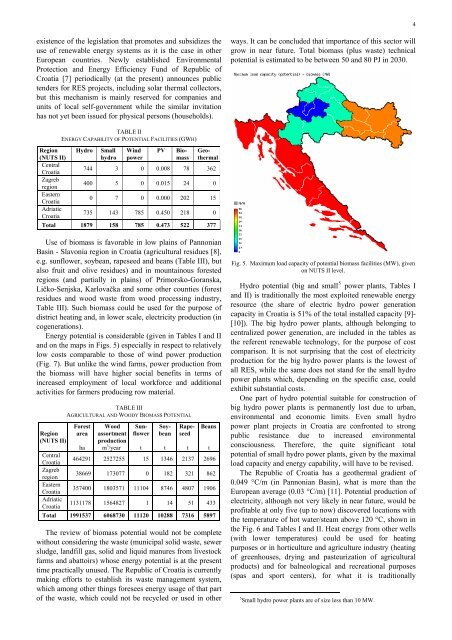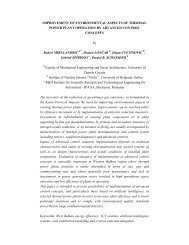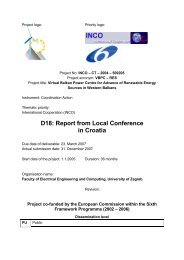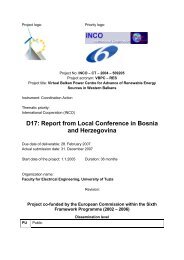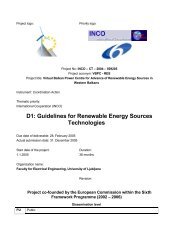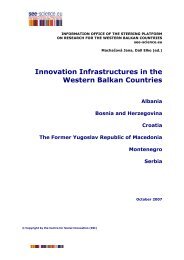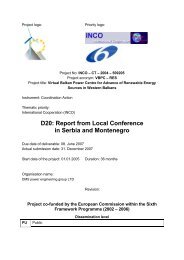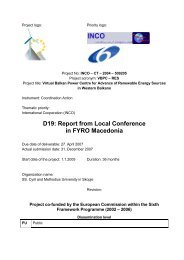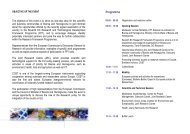Prva stran - WBC-INCO Net
Prva stran - WBC-INCO Net
Prva stran - WBC-INCO Net
Create successful ePaper yourself
Turn your PDF publications into a flip-book with our unique Google optimized e-Paper software.
existence of the legislation that promotes and subsidizes the<br />
use of renewable energy systems as it is the case in other<br />
European countries. Newly established Environmental<br />
Protection and Energy Efficiency Fund of Republic of<br />
Croatia [7] periodically (at the present) announces public<br />
tenders for RES projects, including solar thermal collectors,<br />
but this mechanism is mainly reserved for companies and<br />
units of local self-government while the similar invitation<br />
has not yet been issued for physical persons (households).<br />
TABLE II<br />
ENERGY CAPABILITY OF POTENTIAL FACILITIES (GWH)<br />
Region Hydro Small Wind PV Bio- Geo-<br />
(NUTS II)<br />
hydro power<br />
mass thermal<br />
Central<br />
Croatia<br />
744 3 0 0.008 78 362<br />
Zagreb<br />
region<br />
400 5 0 0.015 24 0<br />
Eastern<br />
Croatia<br />
0 7 0 0.000 202 15<br />
Adriatic<br />
Croatia<br />
735 143 785 0.450 218 0<br />
Total 1879 158 785 0.473 522 377<br />
Use of biomass is favorable in low plains of Pannonian<br />
Basin - Slavonia region in Croatia (agricultural residues [8],<br />
e.g. sunflower, soybean, rapeseed and beans (Table III), but<br />
also fruit and olive residues) and in mountainous forested<br />
regions (and partially in plains) of Primorsko-Goranska,<br />
Ličko-Senjska, Karlovačka and some other counties (forest<br />
residues and wood waste from wood processing industry,<br />
Table III). Such biomass could be used for the purpose of<br />
district heating and, in lower scale, electricity production (in<br />
cogenerations).<br />
Energy potential is considerable (given in Tables I and II<br />
and on the maps in Figs. 5) especially in respect to relatively<br />
low costs comparable to those of wind power production<br />
(Fig. 7). But unlike the wind farms, power production from<br />
the biomass will have higher social benefits in terms of<br />
increased employment of local workforce and additional<br />
activities for farmers producing row material.<br />
Region<br />
(NUTS II)<br />
TABLE III<br />
AGRICULTURAL AND WOODY BIOMASS POTENTIAL<br />
Forest<br />
area<br />
Wood<br />
assortment<br />
production<br />
m 3 /year<br />
Sunflower <br />
Soybean<br />
Rape-<br />
seed<br />
Beans<br />
ha<br />
t t t t<br />
Central<br />
Croatia<br />
464291 2527255 15 1346 2137 2696<br />
Zagreb<br />
region<br />
38669 173077 0 182 321 862<br />
Eastern<br />
Croatia<br />
357400 1803571 11104 8746 4807 1906<br />
Adriatic<br />
Croatia<br />
1131178 1564827 1 14 51 433<br />
Total 1991537 6068730 11120 10288 7316 5897<br />
The review of biomass potential would not be complete<br />
without considering the waste (municipal solid waste, sewer<br />
sludge, landfill gas, solid and liquid manures from livestock<br />
farms and abattoirs) whose energy potential is at the present<br />
time practically unused. The Republic of Croatia is currently<br />
making efforts to establish its waste management system,<br />
which among other things foresees energy usage of that part<br />
of the waste, which could not be recycled or used in other<br />
ways. It can be concluded that importance of this sector will<br />
grow in near future. Total biomass (plus waste) technical<br />
potential is estimated to be between 50 and 80 PJ in 2030.<br />
Fig. 5. Maximum load capacity of potential biomass facilities (MW), given<br />
on NUTS II level.<br />
Hydro potential (big and small 5 power plants, Tables I<br />
and II) is traditionally the most exploited renewable energy<br />
resource (the share of electric hydro power generation<br />
capacity in Croatia is 51% of the total installed capacity [9]-<br />
[10]). The big hydro power plants, although belonging to<br />
centralized power generation, are included in the tables as<br />
the referent renewable technology, for the purpose of cost<br />
comparison. It is not surprising that the cost of electricity<br />
production for the big hydro power plants is the lowest of<br />
all RES, while the same does not stand for the small hydro<br />
power plants which, depending on the specific case, could<br />
exhibit substantial costs.<br />
One part of hydro potential suitable for construction of<br />
big hydro power plants is permanently lost due to urban,<br />
environmental and economic limits. Even small hydro<br />
power plant projects in Croatia are confronted to strong<br />
public resistance due to increased environmental<br />
consciousness. Therefore, the quite significant total<br />
potential of small hydro power plants, given by the maximal<br />
load capacity and energy capability, will have to be revised.<br />
The Republic of Croatia has a geothermal gradient of<br />
0.049 °C/m (in Pannonian Basin), what is more than the<br />
European average (0.03 °C/m) [11]. Potential production of<br />
electricity, although not very likely in near future, would be<br />
profitable at only five (up to now) discovered locations with<br />
the temperature of hot water/steam above 120 °C, shown in<br />
the Fig. 6 and Tables I and II. Heat energy from other wells<br />
(with lower temperatures) could be used for heating<br />
purposes or in horticulture and agriculture industry (heating<br />
of greenhouses, drying and pasteurization of agricultural<br />
products) and for balneological and recreational purposes<br />
(spas and sport centers), for what it is traditionally<br />
5 Small hydro power plants are of size less than 10 MW.<br />
4


